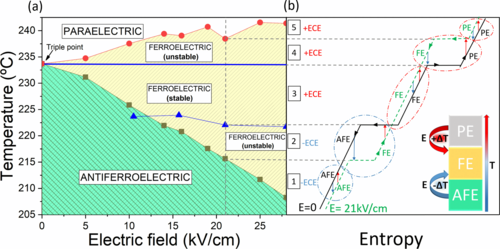Thursday, 25 March 2021
The origin of electrocaloric effect in PbZrO3, explained: antiferroelectric – ferroelectric phase switching
A research led by ICREA Prof. Gustau Catalán, group leader at the ICN2, and published in Physical Review proposes a response to the debate over the origin of the large negative electrocaloric effect observed in antiferroelectric PbZrO3. The understanding of the mechanism at the basis of this phenomenon is also relevant to its application to cooling systems for integrated circuits.

The standard electrocaloric effect is a temperature increment induced by an applied voltage step (and a decrease of temperature upon voltage removal), occurring in ferroelectric materials. It has attracted the interest of researchers in the latest fifteen years, due to its possible application to solid-state cooling systems. An anomalous “negative” electrocaloric effect has been observed in antiferroelectrics, whereby applying voltage causes a decrease in temperature. The microscopic mechanism producing this effect has been investigated and two possible explanations have emerged as the most reasonable.
In a paper recently published in Physical Review B, a thorough study on antiferroelectric PbZrO3 is reported, unveiling which of the two proposed models is actually the dominant cause of the observed effect. This research was conducted by members of the ICN2 Oxide Nanophysics group, led by ICREA Prof. Gustau Catalán, in collaboration with the Luxemburg Institute of Science and Technology, the Barcelona Institute of Microelectronics (IMB-CNM-CSIC), and the University of Silesia in Katowice (Poland). The first author of the paper (and co-corresponding author) is Pablo Vales-Castro, PhD student in Prof. Catalan’s group.
In antiferroelectrics, two sub-lattices of antiparallel electric dipoles coexist. When an electric field is applied, one of the two sub-lattices is de-stabilized, thereby increasing its entropy. This process absorbs heat, and is one of the hypothesis for the origin of the negative electrocaloric effect. However, beyond a critical voltage, the two sub-lattices become parallel. One would expect the entropy to decrease again (since the crystal is now more ordered) and, consequently, heat to be released, but this does not happen. Surprisingly, the entropy of the polar state is much bigger than that of the antipolar state and thus the transition absorbs a lot of heat, resulting in a “giant” negative electrocaloric effect.
Therefore, this effect in antiferroelectric PbZrO3 does not arise from a continuous destabilization of the antiparallel sublattice that characterizes the structure of this material, as one of the proposed explanations suggests, but rather from a first-order endothermal transition between the antipolar and polar phases, induced by the applied voltage variations.
To reach this conclusion, the authors analysed the electrocaloric response of ceramics of the perovskite antiferroelectric archetype, PbZrO3, as a function of voltage and temperature in its phase transition range. The measurements were done using ultrafast infrared video-microscopy. Complementary characterization techniques were used, including dynamic mechanical analysis and differential scanning calorimetry, to confirm the link between the electtrocaloric anomaly and the phase transition and to establish the field-temperature phase diagram.
This research demonstrates conclusively that the substantial electrocaloric effect observed in antiferroelectric PbZrO3 is due to the latent endothermal transition and provides further insight into possible applications. Given that antiferroelectric switching is possible also at room temperature, the electrocaloric effect of antiferroelectrics may have practical advantages over ferroelectrics for integration into micro-refrigerators for electronic circuits.
Reference article:
Pablo Vales-Castro, Romain Faye, Miquel Vellvehi, Youri Nouchokgwe, Xavier Perpiñà, J. M. Caicedo, Xavier Jordà, Krystian Roleder, Dariusz Kajewski, Amador Perez-Tomas, Emmanuel Defay, and Gustau Catalan, Origin of large negative electrocaloric effect in antiferroelectric PbZrO3, Phys. Rev. B, 103, 054112 DOI: 10.1103/PhysRevB.103.054112

